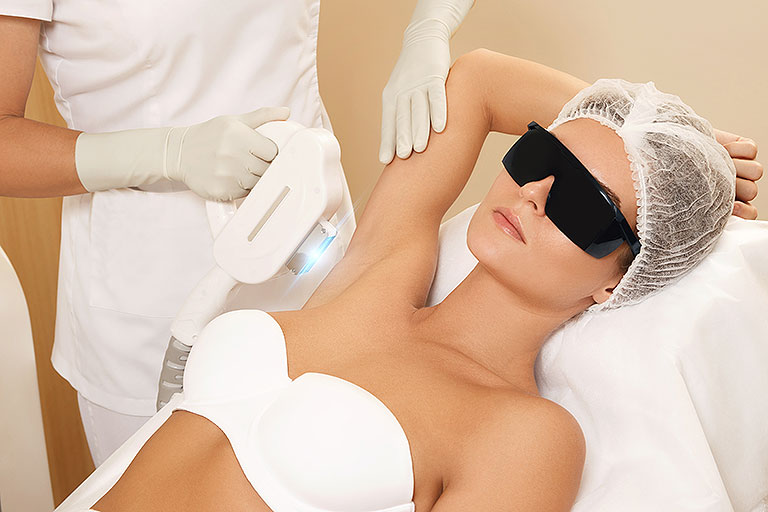Laser hair removal has become a popular choice for those seeking a long-lasting solution to unwanted hair. When considering Laser Hair Removal in Dubai, understanding the relationship between skin types and how well they respond to the treatment is crucial for achieving the best results. This is because the effectiveness and safety of laser hair removal largely depend on your skin tone and hair color, as well as the technology used.
How Laser Hair Removal Works
Laser hair removal targets the pigment called melanin found in hair follicles. During the procedure, a concentrated beam of light is absorbed by the melanin in the hair, which converts into heat that damages the follicle, inhibiting future hair growth. The contrast between the pigment in the hair and that in the surrounding skin determines how effectively the laser can target the hair without harming the skin.
Understanding Skin Types: The Fitzpatrick Scale
To evaluate skin type suitability for laser hair removal, professionals often use the Fitzpatrick scale, which classifies skin types based on their reaction to UV light. It ranges from Type I (very fair) to Type VI (very dark):
- Type I: Very fair skin, always burns, never tans
- Type II: Fair skin, burns easily, tans minimally
- Type III: Light to medium skin, sometimes mild burn, tans gradually
- Type IV: Medium skin, rarely burns, tans well
- Type V: Dark skin, tans very easily, rarely burns
- Type VI: Very dark skin, deeply pigmented, never burns
Best Responders to Laser Hair Removal
Light Skin with Dark Hair (Fitzpatrick I-III)
Individuals with lighter skin tones (Types I to III) and dark hair typically respond best to laser hair removal. The reason lies in the sharp contrast between the light skin and the darker hair pigment, allowing the laser to selectively target the hair follicle with minimal risk of damaging the skin.
- Laser Types: Alexandrite and Diode lasers are especially effective for these skin types.
- Results: These individuals often experience faster and more efficient hair removal, with 70-90% hair reduction after a series of treatments.
- Precautions: It's important to avoid tanning before treatment to reduce risks of side effects like burns or pigmentation changes.
Medium Skin Tones (Fitzpatrick IV)
People with medium skin tones (Type IV), such as some Middle Eastern, Hispanic, or Asian complexions, can also have successful outcomes with laser hair removal. However, the higher melanin concentration in their skin requires specialized laser settings to avoid unwanted side effects:
- Laser Types: Diode lasers are usually preferred, as they can penetrate deeper and minimize skin damage.
- Considerations: The treatment needs to be carefully calibrated and performed by experienced practitioners because there's more melanin in the skin competing with the hair pigment, increasing the risk of burns or hyperpigmentation.
Dark Skin (Fitzpatrick V-VI)
For dark-skinned individuals (Types V-VI), laser hair removal was historically challenging due to the higher melanin concentration in the skin, which absorbs much of the laser energy and raises the risk of burns and pigmentation issues. However, modern advancements in laser technology have improved safety and effectiveness.
- Laser Types: The Nd:YAG laser is considered the safest and most effective for dark skin because of its longer wavelength. This allows the laser to bypass melanin in the skin and selectively target hair follicles.
- Effectiveness: While results might be slightly less dramatic compared to lighter skin types, many dark-skinned patients achieve significant hair reduction with proper treatment and aftercare.
- Special Care: Precision, experience, and proper laser calibration are essential to minimize risks.
Hair Color Impact on Treatment Success
Hair color plays a significant role in laser hair removal outcomes:
- Dark Hair: Because it contains more melanin, dark hair responds best to laser treatments across all skin types.
- Light Hair: Blonde, red, white, or gray hair have less melanin, making laser hair removal less effective. Special techniques or different treatment modalities might be required, and results can vary significantly.
Preparing for Laser Hair Removal Based on Skin Type
Regardless of skin type, preparation is critical:
- Avoid sun exposure and tanning before treatment to reduce pigmentation risks.
- Avoid plucking, waxing, or bleaching the hair before sessions as these remove the hair follicle targeted by the laser.
- Follow your practitioner's instructions carefully to minimize side effects and improve results.
Aftercare Tips
- Keep the treated area cool and moisturized.
- Avoid direct sunlight and use sunscreen diligently.
- Avoid exfoliating or applying harsh skin products immediately after treatment.
- Monitor for adverse reactions like redness or swelling and consult your provider if they persist.
Conclusion
Laser hair removal can be effective across a wide range of skin types if the right technology and techniques are used. Generally, individuals with light skin and dark hair see the best results due to the high contrast that allows the laser to target follicles effectively. Medium to dark skin tones can also benefit significantly from laser hair removal, especially with modern lasers like Diode and Nd:YAG that are designed to safely treat higher melanin levels.
For anyone considering Laser Hair Removal Dubai, understanding your skin type and hair color helps in choosing the appropriate laser technology and managing expectations for the treatment outcome. With advances in laser technology, more people than ever can enjoy the benefits of smooth, hair-free skin safely and effectively.





Comments